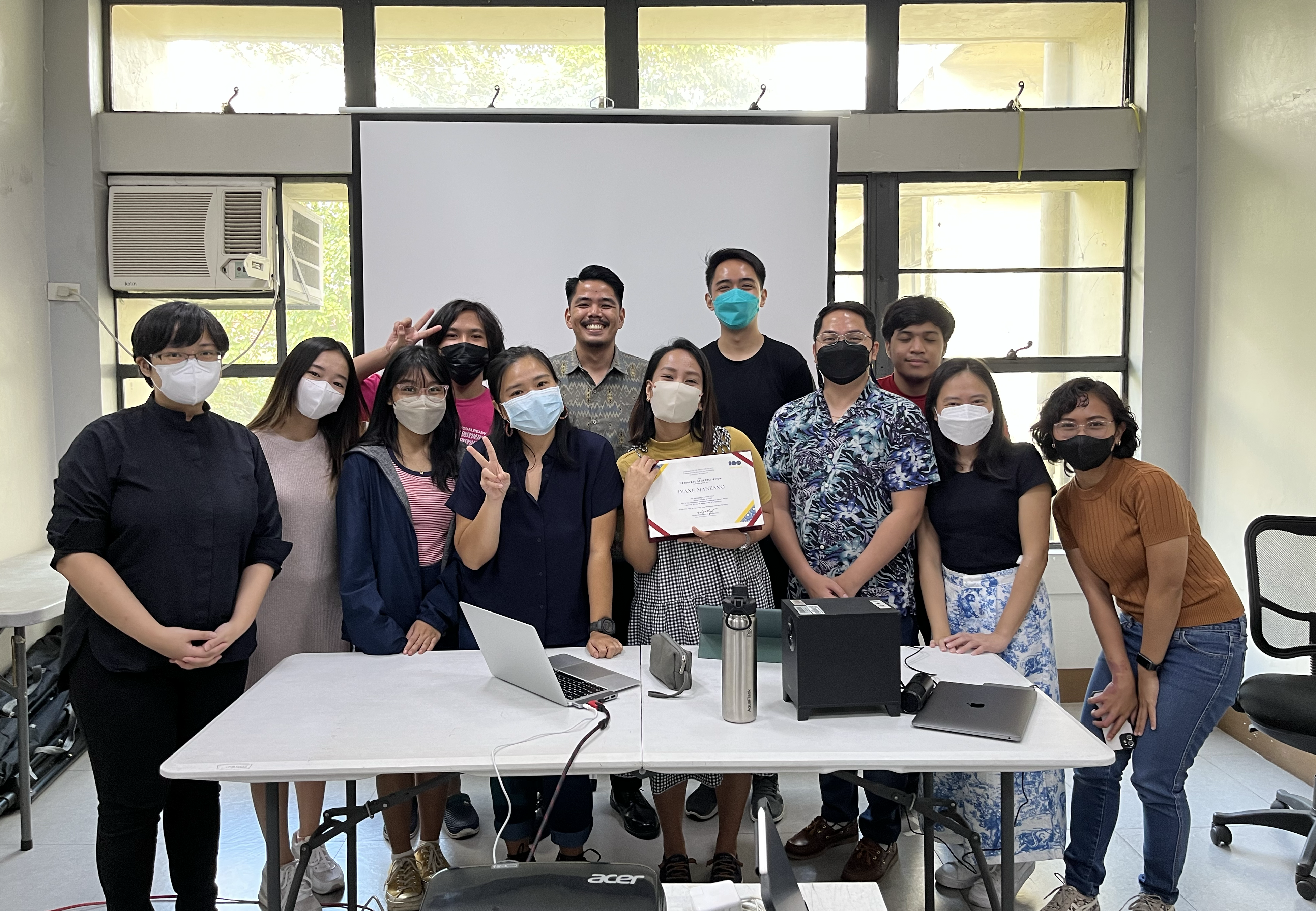
In the first hybrid installment of the 2023 Philippine Indigenous Languages Lecture Series (PILLS), Diane Manzano, assistant professor at the UP Los Baños Department of Humanities and alumna of the UP Department of Linguistics MA program in linguistics, presented some findings on the morphosyntactic structure of Inati drawn from her postgraduate thesis. The lecture, which focused on the description of verbal clauses in the language, was held last 13 February at Palma Hall 1315 for in-person participants and was simultaneously live-streamed via Zoom on the Department’s Facebook page for online attendees.
Manzano’s talk was mainly divided into four parts, with the first one focusing on the background of Inati, including its location, language vitality and some related literature on the language. Next, she discussed the types of data gathered and the elicitation materials that she used. In the third part of her talk, she explained the concepts of valency and transitivity, before diving into the “core” final segment of her lecture on the verbal clauses of Inati.
With different sources estimating the population from around 900 to upwards of 63,000 people, Manzano reports that Inati (also known as Inete and Sogodnin) currently has relatively few fluent speakers. Data from the Philippine Statistics Authority in 2010 shows that 227 households speak Inati, which would suggest that the actual number of speakers to be about 1000 (average household size is 4.6 people). Less than a quarter of them are located in Aklan, and language shift to Aklanon or Hiligaynon is currently being observed among speakers.
“Even though mas malaki ‘yung number ng speakers ng Inati sa Aklan, we saw [a] shift na nangyayari doon sa language nila,” Manzano said. “Most of the Inati speakers are shifting to Aklanon or Hiligaynon, the lingua franca of Panay.”
In most of the related literature, Inati is described as a language isolate, having no demonstrable genetic relationship with any other language. Negrito languages, despite being genetically Austronesian, tend to be relatively conservative and maintain Proto-Malayo-Polynesian (PMP) features that have already been lost in other languages. Inati’s genetic affinity is quite unique, it seems, since it does not appear to have any sister languages.
In describing Inati, Manzano shared that she had the most difficulty in analyzing verbal clausal constructions since it is a highly-contested territory. She categorized this type of clauses according to their valency and transitivity. She explains that “[…] valency refers to the number of noun phrases (or NPs) a verb takes, while transitivity refers to the function of these NPs in a clause vis-a-vis the macroroles S, A, O and E.” In this context, S refers to the sole core argument of intransitive verbs, A for agent, O for object, and E for extension to core, i.e. adjunct arguments that, among other things, may refer to the time or place where an action or event occurred, or the reason or instrument used for an action to take place.
Based on the gathered data, intransitive verbal clauses have verbs which are marked by the affixes <um> or mag-/nag-, nang- and ig-. S, or the sole argument, is in the absolutive case. There are two types: canonical intransitive clauses and extended intransitive clauses.
Canonical intransitive clauses are monadic or monovalent clauses which expects only one core argument and is marked with the absolutive case. In the sentence Ighiwud kay taanak ‘The boy is stretching (his body),’ the verbal predicate ighiwud has a verbal affix ig- and expects only one nominal argument: the singular, non-personal, common noun taanak ‘child.’ This nominal argument is marked with the nominal marker kay which is in absolutive case.
Extended intransitive clauses are different from canonical intransitive clauses in that they have two arguments and are therefore divalent or dyadic. The verbal predicate igmangan ‘ate’ in Igmangan ang taanak ki laswa ki plato ‘The child ate the food on the plate’ has two core arguments: taanak ‘child’ (S) and laswa ‘food made out of vegetables’ (E).
A transitive clause, meanwhile, requires at least two arguments. The first type of transitive clauses, canonical transitives, are dyadic. As we see in the sentence Gingmangan ki taanak ang laswa ki plato ‘The child ate the food on the plate,’ the verbal predicate mangan ‘ate’ (with transitive affix ging-) has taanak ‘child’ and laswa ‘food made out of vegetables’ as its core arguments.
Finally, extended transitive/ditransitive clauses are triadic, meaning that they require three NPs. The first two NPs have an A and O syntactic function, while the third one has E for extension. In Gintudolan i Pia i William ki bato ‘Pia gave William money,’ NP1 i Pia functions as A of the verbal clause, NP2 i William is the O of the clause and NP3 ki bato is E. Even though i William and i Pia have the same personal marker i, the syntactic function is differentiated through word order.
“Inati, like most Philippine languages,” Manzano described, “is first and foremost head-initial. Being head initial, predicates come first and followed by the arguments and then peripheral arguments. […] changing the order will change the meaning of the sentence and the syntactic function of the nouns and would result to Pia becoming the A of the clause and William becoming the O of the clause.”
She ended her presentation by saying that in conclusion, the foundation of her grammar sketch are the following assumptions: Inati is an ergative language and that there are two main verbal clause types, transitive and intransitive clauses. These clauses may be differentiated morphosyntactically, meaning that both verbal morphology and noun markers play a part in showing the transitivity.
The succeeding open forum tackled Inati’s genetic classification, data elicitation and language profile for the methodology, topicalized constructions and non-predicative verbs.
You can watch the recording of the lecture on the Department’s Facebook page. Manzano also published a description of Inati’s current sociolinguistic situation and some of its linguistic features in the Language Documentation and Description journal, which may be accessed here.
This second installment of PILLS was organized by the Department in celebration of its centennial anniversary, and in solidarity with the International Decade of Indigenous Languages as declared by UNESCO.
The next PILLS lecture will be on Bisaja and will be held in March 2023. Keep following the UP Department of Linguistics website and its social media pages for news on this and other events!
Published by John Michael de Pano



